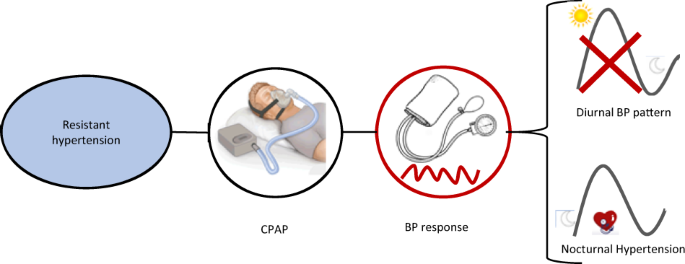
Effect of CPAP treatment on BP in resistant hypertensive patients according to the BP dipping pattern and the presence of nocturnal hypertension
- Select a language for the TTS:
- UK English Female
- UK English Male
- US English Female
- US English Male
- Australian Female
- Australian Male
- Language selected: (auto detect) - EN
Play all audios:
High heterogeneity in the blood pressure (BP) response to continuous positive airway pressure (CPAP) exists in patients with resistant hypertension (RH). Only nondipper normotensive and
hypertensive patients exhibited BP reductions when treated with CPAP; the baseline BP dipping pattern has been proposed as a predictor of BP response to CPAP but has never been explored in
patients with RH. This study aimed to assess the effect of CPAP on BP in subjects with RH with respect to BP dipping pattern or nocturnal hypertension. This is an ancillary study of the
SARAH study. RH subjects with an apnea/hypopnea index (AHI) ≥ 15/h and who received CPAP treatment for 1 year were included. Subjects underwent a sleep study and ambulatory BP monitoring
(ABPM) at baseline and at the 1-year follow-up. Eighty-nine RH subjects were included. The subjects were mainly male (77.5%) and obese, with a mean age of 66 years (25th–75th percentile;
59.0; 70.0) and an AHI of 32.7/h (25th–75th percentile; 25.0; 54.7). A total of 68.5% of participants were nondippers, and 71.9% had nocturnal hypertension. After 1 year of CPAP, no
significant differences in ABPM parameters were observed between dippers and nondippers. According to nighttime BP, subjects with nocturnal normotension did not show significant changes in
ABPM parameters, while nocturnal hypertensive subjects achieved a significant reduction in mean nighttime BP of −4.38 mmHg (−7.10 to −1.66). The adjusted difference between groups was 3.04
(−2.25 to 8.34), which was not significant. This study shows that the BP response to CPAP in patients with RH does not differ according to the BP dipping pattern (dipper and nondipper) and
suggests a differential response according to the presence of nocturnal hypertension (ClinicalTrials.gov: NCT03002558).
We thank all clinical personnel of all participating centers that contributed to the study. This work was supported by IRBLleida Biobank (B.0000682) and PLATAFORMA BIOBANCOS
(PT17/0015/0027). This work was supported by ISCIII y fondos FEDER “Una manera de hacer Europa” (PI19/00907), the Spanish Respiratory Society (SEPAR), ResMed Foundation and Societat Catalana
d’Hipertensió Arterial (SCHTA), Philips and FENIN.
These authors contributed equally: Esther Sapiña-Beltrán, Iván D. Benitez
Hospital Universitari Arnau de Vilanova and Santa Maria, Group of Translational Research in Respiratory Medicine, IRB Lleida, Universitat de Lleida, Lleida, Spain
Esther Sapiña-Beltrán, Iván D. Benitez, Gerard Torres, Dolores Martínez, Manuel Sánchez-de-la-Torre, Ferrán Barbé & Mireia Dalmases
Centro de Investigación Biomédica en Red de Enfermedades Respiratorias (CIBERES), Madrid, Spain
Esther Sapiña-Beltrán, Iván D. Benitez, Gerard Torres, Ana M. Fortuna-Gutiérrez, Juan F. Masa, Jorge Abad, Francisco García-Río, Raquel Casitas, Olga Mediano, Manuel Sánchez-de-la-Torre,
Ferrán Barbé & Mireia Dalmases
Sleep Unit, Respiratory Department, Hospital de la Santa Creu i Sant Pau, Biomedical Research Institute Sant Pau; Universitat Autònoma de Barcelona, Barcelona, Catalunya, Spain
Internal Medicine, Emergency Department, Hypertension and Cardiovascular Risk Unit, Hospital de la Santa Creu i Sant Pau, Universitat Autónoma de Barcelona, Bellaterra, Catalunya, Spain
Respiratory Department, Hospital San Pedro de Alcantara, Cáceres, Extremadura, Spain
Hypertension Unit, Renal Division, Heart Institute (InCor), University of Sao Paulo Medical School, Sao Paulo, Brazil
Unit of Sleep Breathing Disorders, Respiratory Department, Hospital del Mar, Parc de Salut Mar. IMIM. UAB-UPF, Barcelona, Cataluña, Spain
Hypertension and Vascular Risk Unit, Nephrology Department, Hospital del Mar, Parc de Salut Mar, IMIM. UAB-UPF, Barcelona, Catalunya, Spain
Respiratory Department, Hospital Universitari Germans Trias i Pujol, Badalona, Catalunya, Spain
Department of Cardiology, National University Heart Centre Singapore, Singapore, Singapore
Respiratory Department, Hospital Universitario La Paz, Instituto de Investigación Hospital Universitario La Paz, Madrid, Spain
Sleep Unit, Pneumology Department, Hospital Universitario de Guadalajara, Guadalajara, Spain
Publisher’s note Springer Nature remains neutral with regard to jurisdictional claims in published maps and institutional affiliations.
Anyone you share the following link with will be able to read this content: